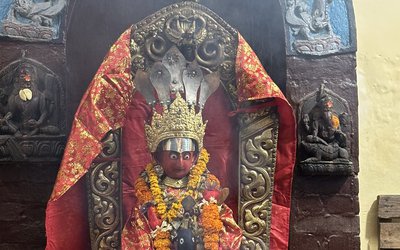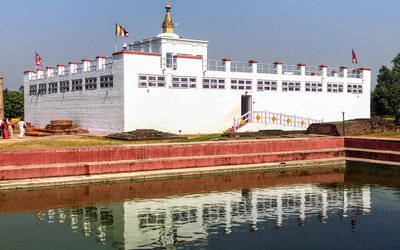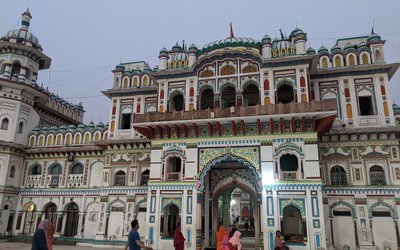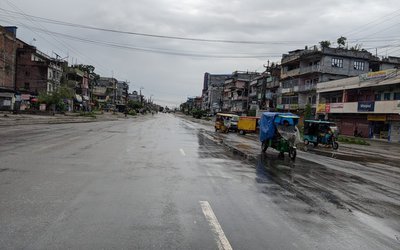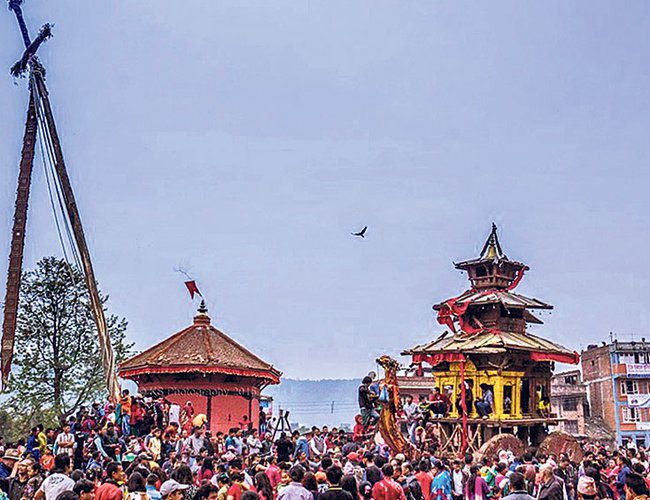
Baisakh 1 is famously celebrated all over Nepal as New Year and it is celebrated all over India as Baisakhi. In Bhaktapur, the popular Bisket Jatra festival is organized.
Bisket Jatra, Bhaktapur's weeklong festival marks the ancient solar Nava Barsha (New Year) and is the only festival that does not follow the lunar-based Nepali calendar. The jatra commences after a special Tantric ritual in th Bhairab temple in Taumadhi Tole in Bhaktapur.
Devotees and participants during the Bisket Jatra at Taumadhi Tole in Bhaktapur, Kathmandu Valley, Nepal.
Nepali calendar 2078, Baishakh
Nepali Calendar 2078 BS begins from today. The multicultural Nepali Calendar with Events and Festivals of all the cultural ethnic groups of Nepal. Nepali Calendar follows detail Nepali panchang to list important festivals like Dashain, Tihar, Teej, Chhath, Lhosar, Eid etc useful for the Nepalese community in Nepal and Abroad.
Bhairav and Bhadrakali are then placed in large chariots (locally known as Rathas) and pulled through crowds of cheering onlookers. During the festival people replay a drama passed on over the centuries.
The chariots, pause for a tuge of war between the easterna and western sides of town and then move down a steep road leading to a river, where a 25-m high lingam (vertical pole) is erected. In the evening the following day, the pole is pulled down, again in a tug of war and as the pole crashes as the official new year commences.
Bisket Jatra is also celebrated in Thimi and Balakhu with Jibro Chhedne Jatra and Sindoor Jatra respectively. The festivities conclude with several days of spiritual entrancement, dancing and merry-making. Bisket Jatra heralds the start of the Nepali New Year and is celebrated with the most aplomb in Bhaktapur. In one of the most exciting annual events in the Kathmandu valley, a huge and ponderous chariot carrying images of the god Bhairab is hauled by dozens of villagers to Khalna Tole. The creaking and swaying chariot lumbers around town, pausing for a huge tug of war between the eastern and western sides of town. After the battle the chariots head to Khalna Tole, where a huge 25m-high lingam (phallic symbol) is erected in the stone yoni (female genital symbol) base.
In the evening of the following day (New Year’s Day), the pole is pulled down, again in an often-violent tug of war. As the pole crashes to the ground, the New Year officially commences.
Variations on the Bisket Jatra theme can also be seen in the villages of Timi and Bode. In the former there’s a parade of images of the gods, with villagers throwing red powder over them. In the latter, there’s a tongue-piercing ceremony, with one villager spending the day with an iron spike piercing his tongue.
In India Baisakhi, also called Vaisakhi, is the harvest festival of Punjab, which people across religions celebrate. This year, it falls on April 14.
Other than harvest, the day of Baisakhi has religious significance too. On March 30, 1699, on Vaisakhi, Guru Gobind Singh established the Khalsa, which is the pure Sikh community. Also known as Vaisakha Sankranti, it marks the beginning of the Solar new year, based on the Hindu Vikram Samvat calendar.
On the day of Baisakhi, Guru Govind Singh asked people to sacrifice their life for the Guru and the Lord. Soon, five people volunteered and they later came to be known as Panj Piaras.
Sikhs make it a point to visit the gurudwara on the day of Baisakhi. In Punjab specifically, langars are organised at various places, and traditionally, Kada Prasad (wheat halwa) is served to everyone. People dress up in fancy, colourful clothes, and in the evenings, people do Bhangra (Punjabi folk dance). Processions of Nagar Kirtans are also carried out, which is nothing but singing from the Holy Book.
Other than Punjab, it is famously celebrated in other states too. In Haryana, the popular Baisakhi Fair is organised.
- Russia launches one of its largest attacks against Ukraine
- Jul 06, 2025
- India notifies WTO of proposed retaliatory duties against US tariffs on autos
- Jul 06, 2025
- PM Oli Returns Home Attending UN FFD4 Summit
- Jul 05, 2025
- Trump signs into law domestic policy bill
- Jul 05, 2025
- Putin-Trump call after US halts some arms shipments to Ukraine
- Jul 04, 2025



